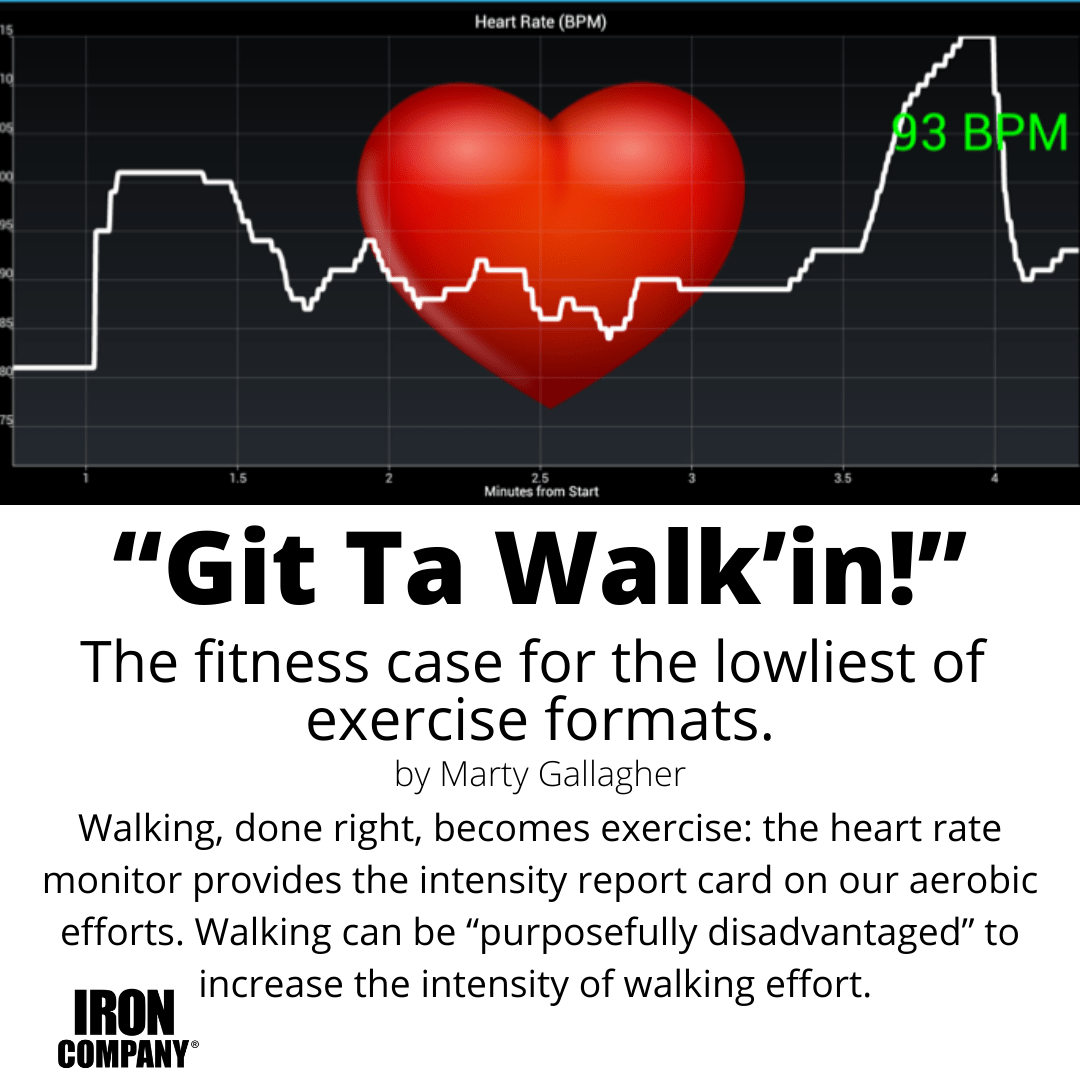
Git Ta Walking
The fitness case for the lowliest of exercise formats...walking
Walking, done right, becomes exercise: the heart rate monitor provides the intensity report card on our aerobic efforts. Walking can be “purposefully disadvantaged” to increase the intensity of walking effort. Walking, and swimming, are the least impactful, of non machine cardio formats.
One of our foundational resistance training strategies is to make light weights heavy. We make lifts and exercises purposefully difficult in a variety of ways, i.e., by insisting on full range of motion, via the use of pauses at the rep turnarounds, slowing down the rep speed, accelerating the rep speed, by invoking subtle technical changes, by shortening rest periods between sets, there are a myriad of ways to purposefully “disadvantage” a lift or exercise, thereby making light weights heavy. Why go to the time and trouble? Making light weights heavy amplifies the difficultly and ergo, amplifies results.
To improve cardio results, amplify cardio difficulty. Our approach is purposefully primitive. What is the most elemental form of cardiovascular exercise? Walking. Can we disadvantage walking to such a degree that it becomes a viable cardiovascular exercise? Absolutely, gear-and-armor-laden soldiers have used disadvantaged walking for centuries.
Roman soldiers routinely carried 25% of their bodyweight in armor and weaponry with every step they took. Modern American Tier 1 spec ops fighters routinely lug 60-pounds of gear and weaponry and are expected to traverse up mountains and hump gear in every type of weather and climate.
Walking can become effective exercise, assuming you can walk with enough velocity and body motion to spike the heart rate – the fundamental goal of all aerobic exercise. Is it possible to make walking an effective aerobic exercise?
Most find walking insufficiently intense to elevate the heart rate to any significant degree. One way to make walking more effective as an exercise format is to revamp walking technique; another is to “purposefully disadvantage” walking via payload or gradient.
Power walking: Power walking is walking with a definitive technique. Definitive technique combined with concentrated effort. Power walking drives the arms, rotates the torso, extends the stride, and seeks to quicken the rate of turnover. Power walking requires the walker stay mentally engaged. Space out, start mentally daydreaming about unrelated subjects and the walking technique immediately collapses. As long as the distracted walker stays distracted, walking ceases to be exercise. Power walking optimizes propulsion via concentration. Power walking in the most basic of all locomotive exercise forms. Only after mastering power walking should the trainee “graduate” to jogging, then running. The serious aerobic trainer, especially the walker, should wear a heart rate monitor. The heart rate monitor provides the report card walking efforts – is our technique correct? Are our efforts sufficiently intense? Without a heart rate monitor, it is all guesswork. The heart rate monitor provides the trainee the cold data needed to plot the next move.
Strap up: The heart rate monitor is an essential piece of fitness equipment for anyone serious about aerobic training. The expense is minimum: purchase an inexpensive chest strap and pair it with one of the many excellent (free) online apps that monitor heart rate and offer an amazing number of options. My app (Polar Beats) provides real time heart rate, session duration, calories oxidized, it even spits out changes in elevation and provides blended-session heart rate averages. It provides “zone” training durations, which I ignore. A heart rate monitor allows the user sees how hard the heart is working (in real time) in relation to the work being done. Why would you ignore this critical piece of data? The heart rate monitor allows the user to access aerobic intensity, something impossible without a HR monitor. Would you lift weights without knowing the poundage? The HR monitor enables the athlete to assess cardio intensity. By being able to quantify how “hard” the trainee is working, classical resistance training periodization tactics can be applied to aerobic exercise. To wit…
10-week periodized “walking cycle” (morphing from out-of-shape to in-shape)
| Week | Duration | Frequency | ARHR Max | Calories | Bodyweight |
|---|---|---|---|---|---|
| 1 | 15-minutes | 3x weekly | 60% (108 heart rate) | 140 | 158 |
| 2 | 17-minutes | 3x | 62.5% | 155 | 156 |
| 3 | 19-minutes | 4x | 65% | 180 | 154 |
| 4 | 21-minutes | 4x | 67.5% | 200 | 152 |
| 5 | 23-minutes | 5x | 70% | 240 | 150 |
| 6 | 25-minutes | 5x | 72.5% | 260 | 148 |
| 7 | 27-minutes | 6x | 75% | 300 | 146 |
| 8 | 29-minutes | 6x | 77.5% | 320 | 144 |
| 9 | 31-minutes | 7x | 80% | 370 | 142 |
| 10 | 33-minutes | 7x | 80% | 370 | 140 |
| 11 | 138 |
Two quick points: try to avoid walking with shoes that have massive “marshmallow heels.” Find flat soled shoes and walk on grass or dirt trails when possible. Secondly: temperature has an impact: spiking the heart rate is far easier on a 90-degree day than a 32-degree day.
- Walking technique: Most walkers “carry” their hands. Pump your arms. The hands should never “float” along, maintaining neutral, non-moving hands. Hands that “float” along as the walker “carries” the hands add nothing to propulsion. For maximum propulsion and pace, consciously “drive” the arms with each stride-stroke. Obviously, the more the walker incorporates the arms into the walking effort, the greater the intensity generated. Pull the elbows back to launch the stride forward with an explosive forward movement of the hands. Rotate the torso to accentuate the power of the stride. Turnover refers to how many strides a walker can take within a specific duration. The faster the turnover the quicker the pace. Seek to increase stride turnover pace without allowing form to degrade.
- The Zen of walking: Walking should not be done on autopilot. Walking should be done with focus and concentration. Concentrate on technique: the instant you start daydreaming, your pace will slacken, you will stop thinking about the mechanics of powerwalking, and walking as exercise loses its intensity and its value. I always listen to music when I power walk. Music enables me to concentrate more fully, to focus better, to walk faster and stay engaged. I walk outside: I walk in Nature, in the woods. Sucking in super-clean woods air while performing concentrated exercise is vastly superior to walking on a treadmill in a public gym, surrounded, inhaling stale recycled building air. Go outside, put on some motivating music, get your head in the game: have a concentrated walking session, strap up and log results.
- Disadvantaging walking: How can we make walking purposefully harder? It is quite easy to disadvantage walking, there are two obvious choices: increase the walker’s payload, i.e., give him a weighted backpack, or, secondly, walk up steep grades. How can you make walking “harder,” i.e., more intense? One way is to wrap a 25-pound barbell plate in a blanket and stuff both into a backpack before taking a power walk. Over time either walk faster or walk further with the 25-pound plate. Or maintain the pace and distance while adding additional poundage to the backpack. The second way to disadvantage walking it to power walk up hills. The steeper the grade the more intense the effort. The ultimate in walking intensity? Walk up a steep grade wearing a weighted backpack.
- Bottom line: Walking can become efficient, appropriate, and, in many (most??) cases all the aerobic exercise a serious fitness devotee would ever need – assuming they were able to generate enough exercise intensity to elicit meaningful cardio results. There is no way to know if you are walking fast enough or hard enough or steep enough or heavy enough unless you are strapped up and wearing a heart rate monitor. Walking without wearing a HR monitor is flying blind. Those that purposefully eschew accessing the heart rate in relation to the exercise being done ignore a critical piece of physiological data. Would you lift weights without knowing the poundage? Walking, done right, becomes a superb form of cardio exercise, particularly for those new to the transformative fitness process.
About the Author - Marty Gallagher
As an athlete Marty Gallagher is a national and world champion in Olympic lifting and powerlifting. He was a world champion team coach in 1991 and coached Black's Gym to five national team titles. He's also coached some of the strongest men on the planet including Kirk Karwoski when he completed his world record 1,003 lb. squat. Today he teaches the US Secret Service and Tier 1 Spec Ops on how to maximize their strength in minimal time. As a writer since 1978 he’s written for Powerlifting USA, Milo, Flex Magazine, Muscle & Fitness, Prime Fitness, Washington Post, Dragon Door and now IRON COMPANY. He’s also the author of multiple books including Purposeful Primitive, Strong Medicine, Ed Coan’s book “Coan, The Man, the Myth, the Method" and numerous others. Read the Marty Gallagher Biography for a more in depth look at his credentials as an athlete, coach and writer.



